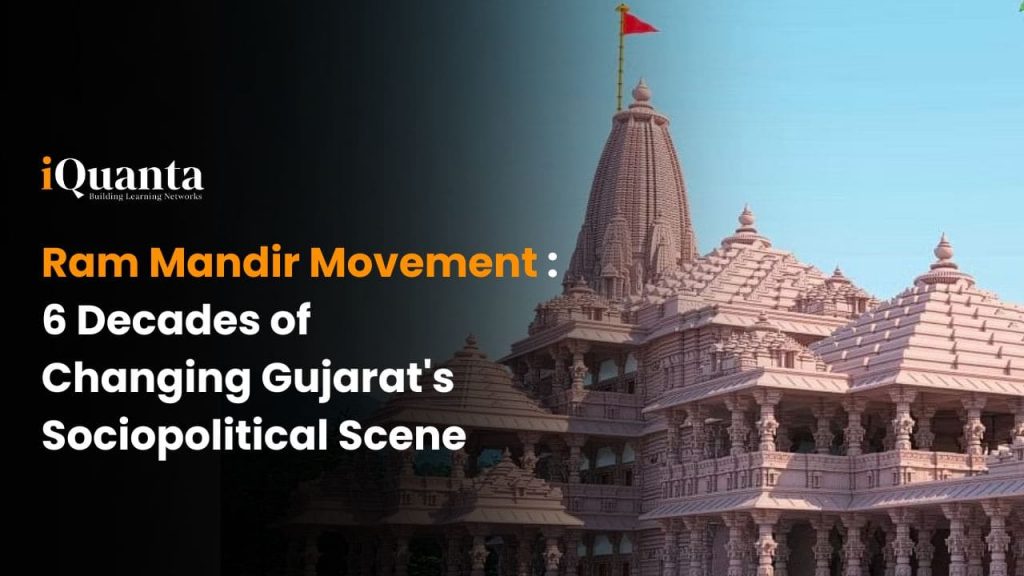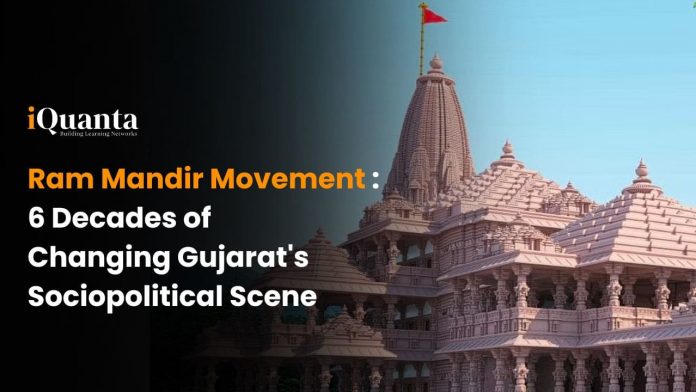
Genre : Socio-Political & Current Affairs
During the last sixty years, one movement in particular—the Ram Mandir movement—stands out for having radically altered Gujarat’s geopolitical landscape. This movement, led by the Vishwa Hindu Parishad (VHP), was crucial in securing the Bharatiya Janata Party’s (BJP) hold on the state’s hinterland and, consequently, in shaping national politics. It also provided the groundwork for the construction of the Ram temple.

Genesis of the Movement
Early in the 1980s, the Vishwa Hindu Parishad helped the Ram temple movement in Gujarat pick up steam. At first, the campaign consisted of penning letters to the Union government requesting that the Ram temple’s locks be opened. But with the backing of Hindu seers from all faiths and the active participation of Rashtriya Swayamsevak Sangh (RSS) and its affiliates, it went from being an urban affair to a mass movement, inspiring voters with yatras and public outreach programmes.
Political Impact on BJP
The BJP had a difficult time in Gujarat in the 1980s; by 1984, it had only two Lok Sabha seats and was only allowed to operate in cities. Still, the political atmosphere supported the party’s comeback. The BJP’s return was made possible by the Ram temple campaign, which was sparked by the divisive atmosphere that followed Rajiv Gandhi’s position on the Shah Bano case. A watershed was reached in 1987 when the BJP won an outright majority in the Ahmedabad Municipal Corporation through civic body elections.
AB Vajpayee’s Contribution to the BJP’s Resurgence
The BJP’s comeback was paved with AB Vajpayee’s December 1986 public meeting in Bapunagar, where he urged people to give the party the responsibility of sweeping the streets. The BJP’s political fortunes began to change in January 1987 when it secured an absolute majority in the Ahmedabad Municipal Corporation. The party’s grassroots influence was further reinforced in 1989 by the Shila Pujan campaign and its vigorous pursuit of the Ram Mandir agenda.
Formation of Bajrang Dal and Rural Penetration
The establishment of Bajrang Dal in 1985 was a momentous occasion that paved the way for initiatives like Trishul Diksha, which successfully impacted Gujarat’s rural areas. The BJP formed a coalition administration with the Janata Dal in the state by 1990 after winning 12 Lok Sabha seats by 1989. The Sangh affiliates, such as Durga Vahini, Bajrang Dal, and VHP, were instrumental in expanding the impact of RSS outside of cities.
Rath Yatra and the Ascent of the BJP:
Massive public outcry followed LK Advani’s Rath Yatra to Ayodhya on September 25, 1990, which was led by a teenage Narendra Modi and Pramod Mahajan. When the BJP won 20 Lok Sabha seats in Gujarat by 1991, it made an announcement about its entry into state politics. Following their break with Janata Dal, the party pressed forward with the Ram Mandir agenda, Pravin Togadia spearheading the effort while Narendra Modi worked behind the scenes.
Following the Babri Mosque Demolition:
Kar Sevaks returned home in joy following the landmark 1992 Babri Mosque demolition. In the state assembly election of 1995, the BJP won 121 seats with a resounding victory, toppling the Congress-JD coalition government headed by Chiman Patel. Gujarat has continued to be a BJP stronghold ever since, often electing the party to power.
Conclusion:
In conclusion, there is no denying the influence of the Ram Mandir movement on Gujarat’s sociopolitical climate for the past sixty years. It set the stage for the BJP’s eventual comeback and domination in the state, evolving from an urban-focused campaign to a mass movement that swept over rural areas. In addition to helping to build the Ram temple, the movement was crucial in determining Gujarat’s political course and establishing the BJP’s base there.

